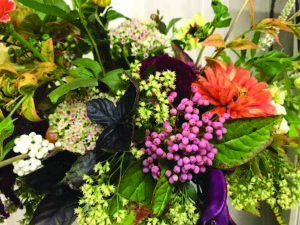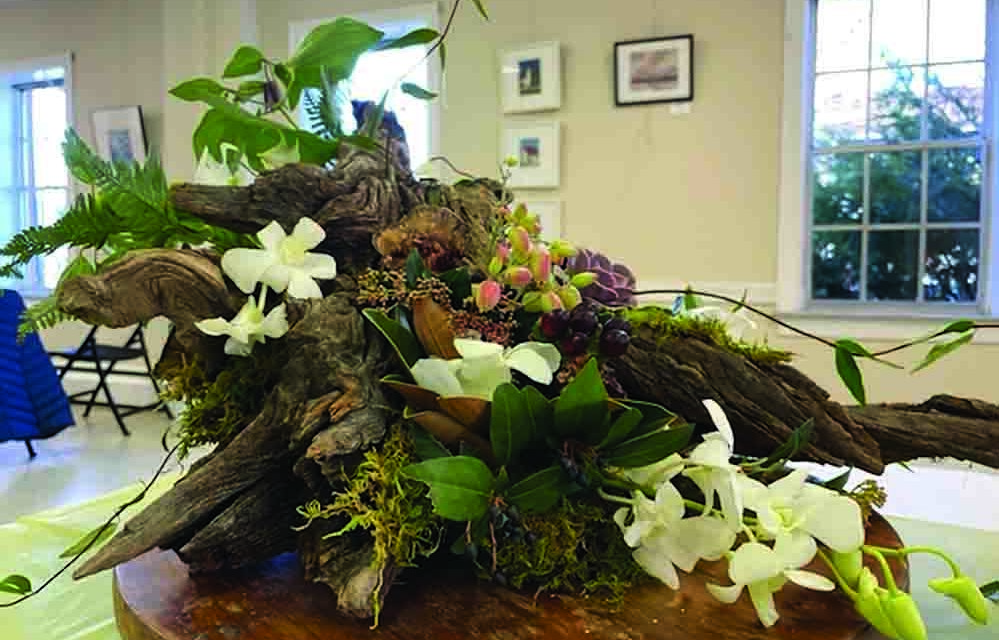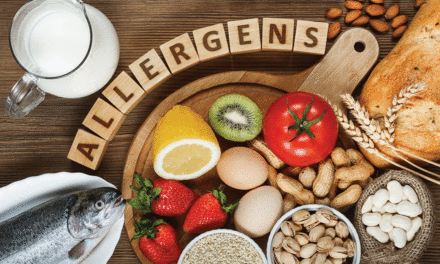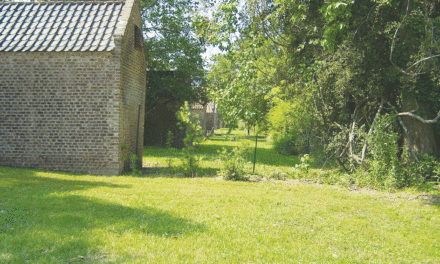
Incorporating native plants like Baccharis flowers, Viburnum berries and Solidago can add something unique to an arrangement. (Photos courtesy Nancy Beatty)
Gardeners are getting on board with using native plants to create a more sustainable landscape for birds, bees, butterflies, and bugs.
But how about those hoping for a harvest of cut flowers to beautify bouquets, enhance arrangements, and grace a vase for more than a day?
Fortunately, this region is home to native flowers which, while helping create ecologically healthy habitat, can also add a stunning “wow” factor.
Mary Lewis of Blue Water Baltimore’s Herring Run Nursery says that many are already widely known, such as Maryland’s state flower, the Black-Eyed Susan, as well as coneflower, goldenrod, and aster.
Those and others such as sneezeweed, mountain mint, false sunflower and coreopsis, sea oats and ferns, are among her favorites which she’s found to have worked well.
Following its March 17 season opening, Herring Run should typically stock them all, plus several she also recommends, mentioned by Longwood Gardens horticulture assistant Michele Christiano in a recent Fine Gardening Magazine article.
Topping that list is Eastern Bee Balm, Willow leaf Bluestar, “Annabelle” smooth hydrangea, and David and Jeanna Garden Phlox, which performed well in Mt. Cuba Center trials.
Members of the Facebook group Maryland Area Gardening for the Environmentally Conscious offered additional ideas, among them, Carolina lupine, Liatris Blazing Star, Anise Hyssop, and ferns such as Ostrich Germ,
But there are other more ‘exotic’ natives to be recommended for cutting and arrangements, according to Nancy Beatty, owner/operator of Sweetbay Flowers in Royal Oak.
Some of her favorites include Turtlehead, Culver’s Root, Obedient Plant and even Rattlesnake Master, a member of the Yucca family she learned about while visiting a Kent County gardener’s nearby field.
Beatty has cultivated an organically landscaped garden for over 25 years, while also growing a flourishing floral design business.
As a longtime docent at Adkins Arboretum in Ridgely she’s learned to appreciate native varieties, incorporating many while leading workshops to create striking seasonal arrangements.
But beyond flowers and buds, Beatty also taps the decorative potential of vine and shrub blossoms, tree leaves, seedpods, stems, fruits, and berries, and urges home gardeners to look at the big picture.
When looking to fill out bouquets and arrangements, she seeks attractive blooms but also appreciates a plant’s structural potential and its longevity.
For those that catch her eye but may not hold up as well as others, she mixes them in with other things.
A number of the natives she’d recommend bear a resemblance to varieties that don’t originate here, so gardeners should be wary when hearing familiar sounding names without the words “false” or “wild.”
One of these is Baptisia, or false indigo, which Beatty loves for its pretty blue flowers on long tall stalks.
Another is Penstemon, also called beard tongue, which makes a wonderful cut flower, particularly the Husker’s Red cultivar. (Penstemon digitalis or foxglove beardtongue is a native member of the snapdragon family and puts out white or pink flowers. Don’t confuse it with common foxglove, digitalis purpurea, however, as it is poisonous to pets and humans and is considered invasive in many areas.)
Among Beatty’s other favorite wildflowers to use is Joe Pye Weed.
“It blooms in mid to late summer and the butterflies just love it. And it holds up a long time, has kind of a pinky mauve color,” she said. (A similar but separate variety, known as Butterfly weed (Asciepias tuberosa) is sometimes called orange milkweed).
She’s also a fan of Heuchera villosa, a type of coral bell called hairy alumroot or autumn bride, featuring a whitish creamy green cluster of flowers at the top in late summer or fall, as well as the colorful wild (also called Red or Canadian) columbine, a member of the buttercup family Ranunclaeceae.
Silvery green Mountain mint with beautiful little white flowers requires special care due to its spreading potential, she added.
While vines can be problematic in the garden, Beatty has found joy using some of their flowers, including Yellow jasmine (or Carolina yellow jessamine) (a very early Spring bloomer), Bignonia, or crossvine (with blossoms similar to but smaller than trumpet vine), and honeysuckle. Yellow jasmine and crossvine leaves stay evergreen, and she includes them in arrangements year around.
Shrubs are also on Beatty’s recommendation list, such as Clethra, also called summersweet or sweet pepperbush is “great for cutting” with white and sometimes pink cultivars. Witch hazel works well with a pleasing clove-like aroma. With Hydrangea Arborescence (Annabelle), which isn’t as long lasting, she waits until the white blossoms begin turning green, and the leaves get somewhat papery.
Ninebark diablo features really nice burgundy leaves and little white flowers with pink in them all up and down the stems in the spring, Beatty noted.
A number of trees factor into the mix as arrangement matter sources, among them, the tough to grow but outstanding Sourwood tree (“It’s leaves are just as Red as can be in the fall; in spring there are pretty delicate white lily of the valley type blooms,” she mentioned.)
Native Dogwood, whose blossoms don’t last as long, provides much beneficial structure. So too do beech tree stems which in late winter feature interesting points resembling birds’ feet.
The native persimmon provides pleasing ornamental color in the fall, if they can be gathered before the possums get to them.
Bald cypress contains cones that form in twos which, if caught at just the right time, work very well in arrangements. And the Aronia tree provides “nice little white flowers” in spring, then red berries, some of which were still around in February, Beatty noted.
Barbara Martin, who assists native plant nursery Butterfly Alley in Hollywood, Md., (https://butterflyalley.net), suggests that when in doubt about which natives will work for your cutting garden needs, contact your local garden club, which usually participate in flowers shows and horticultural events at State Fairs and other venues.
Martin checked in with St. Mary’s County Garden Club members, who had contributed to some of last year’s National Parks themed arrangements, and learned that Rudbeckia hirta (Black-Eyed Susan), Echinacea (Coneflower), and Solidago (Goldenrod) all held up well on minimum water (Oasis) for several days.
For particulars about area native plants, Beatty recommended contacting Adkins Arboretum (https://www.adkinsarboretum.org) and Environmental Concern in St. Michaels is another local producer and source for native plants. (https://wetland.org).
Other information sources include the Mt. Cuba Center (https://www.mtcubacenter.org), the U.S. Forest Service (https://www.fs.fed.us), Maryland Biodiversity (https://www.marylandbiodiversity.com), the University of Texas Lady Bird Johnson Wildflower Center (https://www.wildflower.org), and the Missouri Botanical Garden (https://www.missouribotanicalgarden.org/Plantfinder).







